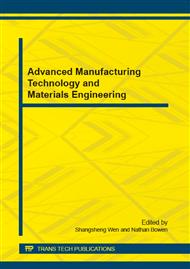[1]
T. FAN, Z.N. Li, Y.X. XIAO, Blind separation of mechanical source signals based on the estimation of source numbers. Journal of Mechanical Strength, 2011, 33(1): 15-19(In Chinese).
Google Scholar
[2]
Y. Li, Y.Y. He, Z.N. Li, et al. Study on application of blind source separation and wavelet denoising in rubbing fault acoustic signal analysis. Journal of Mechanical Strength, 2005, 27 ( 6) : 719-724(In Chinese).
Google Scholar
[3]
Z.N. Li, J. Han, J.J. Sun, et al. Fault Recognition Method Based on Independent Component Analysis and Hidden Markov Model. Journal of Vibration and Control, 2007, 13(2): 125-137.
DOI: 10.1177/1077546307066964
Google Scholar
[4]
Z.N. Li, Y.D. Zeng, T. Fan, et al. Source Separation method of Machine Faults Based on Post-Nonlinear Blind Source Separation. Proceedings of the 7th World Congress on Intelligent Control and Automation, June 25 - 27, 2008, Chongqing, China, pp.1786-1789.
DOI: 10.1109/wcica.2008.4594464
Google Scholar
[5]
A Table, C Jutten. Sources separation in Post-nonlinear mixtures. IEEE Trans. Signal processing, 1999, 47: 2807-2820.
DOI: 10.1109/78.790661
Google Scholar
[6]
H. Lappalainen, A. Honkela. Bayesian nonlinear independent component analysis by multi-layer perceptions. In advances in independent component analysis (M Girolami, ed), Berlin: Springer-Verlag, 2000: 93-121.
DOI: 10.1007/978-1-4471-0443-8_6
Google Scholar
[7]
Francis R. Bach, Michael I. Jordan, kernel independent component analysis. Journal of Machine Learning Research, 2002, Vol. 3: 1-48.
Google Scholar
[8]
Francis R Bach, Michael I Jordan. Kernel Independent Component Aanlysis. Journal of Machine Learing Research, 1998, 10(5): 1299- 1319.
Google Scholar
[9]
Francis R B, M ichael I J Kernel independent component analysis [J]. Journal of Machine Learning Research, 2002, 2(3): 1246-1248.
Google Scholar
[10]
A. Hyvärinen and E. A Oja. fast fixed-point algorithm for independent component analysis. Neural Computation, 1997, 9(7): 1483-1492.
DOI: 10.1162/neco.1997.9.7.1483
Google Scholar
[11]
A. Hyvärinen. Fast and robust fixed-point algorithms for independent component analysis. IEEE Transactions on Neural Networks 1999, 10(3): 626-634.
DOI: 10.1109/72.761722
Google Scholar
[12]
J -F. Cardoso and Souloumiac A. Blind beamforming for non-Gaussian signals. Radar and Signal Processing, IEE Proceedings F, 1993, 140(6): 362 -370.
DOI: 10.1049/ip-f-2.1993.0054
Google Scholar
[13]
A. J. Bell and T. J. Sejnowski, An information maximization approach to blind separation and blind deconvolution, Neural Computation, 1995, 7(6): 1129-1159.
DOI: 10.1162/neco.1995.7.6.1129
Google Scholar
[14]
J. F, Cardoso and B. Laheld, Equivariant adaptive source separation. IEEE Transaction on Signal Processing, 1996, 44(12): 3017-3029.
DOI: 10.1109/78.553476
Google Scholar


